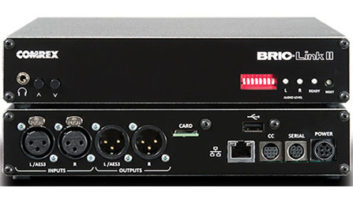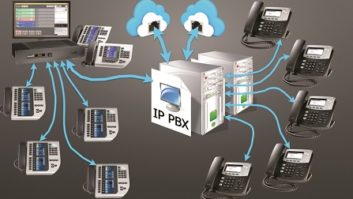While the end of ISDN may not be as certain as death or taxes, it is coming eventually. There are places around the U.S. where you can no longer order ISDN, and places where you still can (such as from AT&T here on the West Coast).
But we must consider two very practical issues.
First, the obsolescence of the central office switches. I found this little gem online from the University of Missouri: The University’s ISDN switch is now obsolete, cannot be placed under vendor warranty or maintenance, spare parts are not available, and no spare units are in stock. If the device should fail again, it cannot be repaired.
How many CO switches around the country are in the exact same shape?
Second, even if the CO switches could go forever, who would know how to configure or fix them? From the Comrex white paper “Making the Transition From ISDN to IP” comes the following truism: “Troubleshooting ISDN circuits is a difficult task and many experienced ISDN technicians have retired.”
In spite of the fact that use of ISDN for remote broadcasts is still very commonplace (using existing circuits), it’s time to look at alternative ways to carry out this function, which is crucial to so many stations around the country.
The time has come to transition from ISDN to AoIP codecs.
COMMON AOIP FEATURES
Let’s first consider features that are common to nearly all audio over Internet protocol codecs.

Full duplex. One of the best features of ISDN codecs and their AoIP successors is their full-duplex nature. Older analog loop circuits don’t provide this, of course, and RPU links don’t either. Long gone is the need for a POTS line, or even a cellphone, for cuing.
Dual channels. Again, like ISDN codecs before them, the majority of the AoIP codecs are dual-channel. This is very convenient for cuing and/or talkback purposes and provides a great way to send a PA feed to the remote.
Audio bandwidth. While ISDN codecs usually sounded very good, AoIP codecs, using a (reliable) high-speed IP connection can sound remarkably good — almost “too good,” as if you were not really at a remote at all. This is the kind of problem that’s good to have.
Remote controls. Most of the codecs we’ll talk about provide some means to send (and receive) contact closures to and from the remote site. Of course, since IP communication is obviously in use, many remote users rely on a computer on the far end to provide remote control of, for example, an automation system. Similarly, most of the codecs provide a means to send serial data, as well.
Field configuration. The setting-up of a remote AoIP codec will often require the user to configure the Ethernet and IP settings (unless they are known ahead of time). The three basic settings (IP address, subnet mask and gateway) can be done from the front panel in most devices. DHCP is an option in most, if not all of the codecs; however, reliance strictly upon that method isn’t recommended. Your user needs a minimum amount of training in the use of the device.
For the sake of expense, some manufacturers have gotten rid of front-panel controls; in that case, you’ll need a computer placed on the same network for configuration.
COMMON IP PROBLEMS
While the evolution of IP technology has provided many benefits, there are issues associated with its use as well.
The primary advantage of ISDN is that the circuit is “nailed up” inside the PSTN system and the channel bandwidth (i.e., two DS0s) is for your exclusive use for the duration of the call. The nature of IP communications is radically different; the Internet is a big, shared system, and the problems one will eventually encounter all stem from that. IP is the most brilliant means of communication yet devised — but it’s not perfect. The AoIP codec manufacturers have all addressed the packet delay/loss issues associated with IP transmission in their own ways.
Most of the AoIP codecs we’re going to talk about in this article are rack-mount devices, meant to communicate with similar devices on the far end.
An exception is the Comrex Access 2USB, a portable AoIP codec mean to live out in the field. (Its complement in the rack room is the Access rack.) Access 2USB’s physical size and form factor allow it to sit on a table top, to be strapped to your belt or held in one hand as the user walks around. The device is powered with its own internal, rechargeable battery or a DC-adaptor. It has a switchable mic/line level input via XLR, and stereo line-level inputs with an integrated mixer; stereo lineouts and the stereo headphone out are both available via 1/8-inch mini-jacks. Communication can be done via the single RJ-45 Ethernet connector, or via one of the two native USB ports, using Wi-Fi or POTS modems, or via an optional 3G/4G modem. Separate DIN connectors are used for both serial data and contact closure transmission. Configuration of the device can be done via the front-panel LCD display and a stylus, or by way of Comrex BRIC Device Manager, a free Windows app that allows for configuration (via IP) of Access codecs as well as firmware and license updates.
Comrex BRIC Technology is a suite of tools that includes Dynamic Jitter Buffer Management and error correction. They’ve developed what they call “BRUTE” — BRIC UDP Transmission Enhancement to help maintain stable and reliable transmission on marginal networks. UDP Reliability and Congestion Avoidance modes in BRIC are intended to provide extra error protection with a minimal increase in latency. Algorithms include BRIC HQ, along with AAC, AAC-LD (low delay), HE-AAC (high efficiency), HE-AACv2 and AAC-ELD.
Like all of the manufacturers mentioned in this article, Tieline has a line of codecs designed for AoIP usage.
Genie Distribution supports transmission of audio over IP, and optionally, POTS and ISDN — making it a possibility for your ISDN-to-IP transition period. The device is called Genie Distribution because it is capable of sending multiple algorithms simultaneously at different sample rates and bit-rates over a range of network transports. Genie Distribution is a single-RU, full-duplex codec, capable of handling up to six channels of audio, the first two of which are available via XLR connectors and the final four of which are available via a db25 connector (24-bit word and up to 96 KHz sample rate). The device features two independent Ethernet connections, and supports RS-232 and GPIO via separate D connectors.

Configuration can be done from the front panel or via the embedded Web server. Algorithms include E-apt-X, linear PCM, LC-AAC, HE-AAC v1 and v2, AAC-LD, AAC-ELDv1 and v2, Opus, MPEG Layer II, Tieline Music and MusicPLUS, G.722 and G.711. The user will be able to connect over IP with any SIP-enabled IP codec brand that supports the EBU N/ACIP EBU tech 3326 standard.
Genie Distribution includes SmartStream, which is Tieline’s suite of features used to mitigate potential IP network problems. Automated Jitter Buffer management, Forward Error Correction and error concealment dynamically respond to the variable conditions that can be encountered so that streaming quality is maximized. The device can support up to 50 unicast connections and an unlimited number of end-points via multicast (with a network supporting IP multicast).
The Telos Z/IP One is another single RU AoIP codec designed and built for remote broadcasts. It features two channels in, and two channels out, via XLR connectors, and configurable levels, with 24-bit A/D and D/A converters. (AES i/o is optional.) Z/IP One is N/ACIP conforming and supports AAC-ELD, AAC-HE, AAC-LD, MPEG Layer-2, MPEG-4 AAC-LC, MPEG-2 AAC-LC, G.711, G.722 and linear PCM (Enhanced aptX coding optional). It features two Ethernet ports, one of which can be used for control, and the other for the streaming functionality, including Livewire+ (audio and control). It also has time-aligned RS-232 serial throughput for remote control, and transmission of metadata.

Configuration of Z/IP One can be done via the embedded Web browser, but there are also front-panel headphone controls, a direct-dialing keypad, quick-connect keys and an OLED display giving the user access to common functions and the system set-up.
Telos’ proprietary technology for dealing with the inevitable network problems is called Agile Connection Technology; it automatically senses network conditions and adapts the codec parameters to best suit the reliable transportation of audio.
Since we are on the topic of the transition from ISDN to IP, it’s important to note that Z/IP One is backward compatible with Zephyr Xstreams.
APT (from Worldcast) offers a wide line of devices to move audio over IP, including the IP Codec (formerly known as the Horizon NextGen). It’s a single RU, dual-channel codec, featuring analog inputs and outputs via XLR connectors, as well as digital ins/outs via AES-3 (24-bit word length, 32, 44.1, 48 kHz sample rate; 192 kHz sample rate optional). IP Codec has two Ethernet ports. Serial data is supported via RS-232 (9-pin D connector) and GPIO is provided via a 15-pin D connector. Standard encoding options are apt-X (16 or 24-bit); Linear PCM (16 or 24-bit); MPEG 1/2 layer 2; MPEG4: AAC-LC/LD/ELD; and, MPEG 2/4: HE-AAC versions 1 and 2. With no front-panel controls, IP Codec would have to be configured in the field by use of a computer (or configured ahead of time).

Streaming modes for IP Codec are unicast, multiple unicast, multicast and multiple-multicast using RTP/UDP or RTCP. Other IP protocols supported for management purposes include dynamic DNS, ICMP, IGMP, UPnP, NTP, SNMP, SMTP and HTTP. IP Codec is configured by way of the APT network management system UI.
To mitigate transmission problems associated with the use of IP, IP Codec includes several features: Buffer depth is adjustable, between 5 and 5000 milliseconds, and the device has automatic packet re-sequencing. IP Codec also features the APT Surestream, a means by which the device sends two independent streams, meant for different transmission paths, to the receive end. The key idea behind Surestream is that packets lost on one path can be recovered by using those received on the other path.
Another European company that deserves a look is AEQ. They produce an extensive line of IP codecs, including one device specifically meant for remotes, the Phoenix Alio. A few of its more important features are four XLR mic-level inputs; two XLR line-level inputs; two XLR line level outputs, and two 1/4-inch TRS headphone outs. Alio is meant to communicate via IP and has a single RJ-45 connector. Interestingly (with a second channel option installed) Alio will support two simultaneous IP connections. You could potentially be supporting your audio connection for the remote and an additional audio session for cuing or other technical/production purposes.

Coding algorithms include OPUS (48 kHz SR, data rate between 12 and 256 kpbs); G.711 (u-law or a-law); G.722; MPEG layers 1 and 2; and PCM (32 or 48 KHz sample rate, 12, 16, 20 or 24-bit word length).
Phoenix Alio is N/ACIP compliant, and therefore it can connect to other manufacturers’ devices, at least via G.722 or MPEG layers 1 and 2; however, if you wanted an AEQ system on both ends, you could select Phoenix Studio, Venus, Mercury or Stratos. ControlPhoenix is remote control software that allows the user to configure and adjust Alio in real time, even down to trimming the audio levels on the far end.
Barix is a Swiss company known for a family of products used to transport audio via IP. They became familiar to the broadcasting community after the introduction of the Instreamer (the encoder) and the Exstreamer (the decoder). The Exstreamer 500 is a codec though, a pair of these units makes up a full-duplex system. The 500 features two channels of balanced line-level audio (in and out) available on removable connectors; RS-232 and RS-485 for serial data; and four relay inputs/outputs. Configuration is done via built-in Web browser. The 500 supports a stereo codec for MPEG1&2 Layer3 (MP3, 30-192 kbps variable bit rate), PCM linear, a-law and u-law, from 8-48 kHz sample rates. The decoder also supports AAC+ (AAC-LC, HE-AAC, HE-AAC v2). A USB flash interface allows use of external memory to store audio files that the 500 will play out as necessary. Streaming methods include TCP, UDP, RTP and multicast.

Remote broadcasts, whether for high-school football, or college basketball, or the obligatory Saturday afternoon car dealer remote, are one thing that is practically unique to radio. The technology for carrying them out has, fortunately, gotten better, and remotes are far easier than they used to be. They’re also a great way to show listeners and advertisers what radio can really accomplish as a medium; for that reason, you should take it upon yourself to see that they deliver as promised, in a professional manner.







